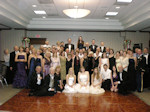 05/15/2010 - The 5th Annual Hungarian May Ball continued its tradition of supporting the community. Proceeds of the 2010 Ball benefitted the Hungarian Parochial School in Vaján, Slovakia, to help maintain the community's Hungarian Cultural Heritage and Language and USMA 1969 Claude Alexander Volunteer Program Supporting Walter Reed Army Medical Center. 05/15/2010 - The 5th Annual Hungarian May Ball continued its tradition of supporting the community. Proceeds of the 2010 Ball benefitted the Hungarian Parochial School in Vaján, Slovakia, to help maintain the community's Hungarian Cultural Heritage and Language and USMA 1969 Claude Alexander Volunteer Program Supporting Walter Reed Army Medical Center.
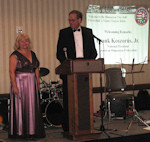 Frank Koszorus, Jr., President of the American Hungarian Federation, welcomed guests and thanked the Ball Committee and its chairperson, Erika Fedor "who worked tirelessly to make this wonderful event happen." He then added a few words about the American Hungarian Federation – "it is the largest Hungarian-American umbrella organization as well as one of the oldest ethnic organizations in the United States. It was founded in 1906 in Cleveland, Ohio at a time when the map of Hungary looked much different, as you can see from the plaques in this hall depicting that country’s dismemberment by the punitive 1920 Treaty of Trianon – dismemberment of a self-contained, geographically and economically coherent and durable formation in the Carpathian Basin and boasting the longest lasting historical borders in Europe. Frank Koszorus, Jr., President of the American Hungarian Federation, welcomed guests and thanked the Ball Committee and its chairperson, Erika Fedor "who worked tirelessly to make this wonderful event happen." He then added a few words about the American Hungarian Federation – "it is the largest Hungarian-American umbrella organization as well as one of the oldest ethnic organizations in the United States. It was founded in 1906 in Cleveland, Ohio at a time when the map of Hungary looked much different, as you can see from the plaques in this hall depicting that country’s dismemberment by the punitive 1920 Treaty of Trianon – dismemberment of a self-contained, geographically and economically coherent and durable formation in the Carpathian Basin and boasting the longest lasting historical borders in Europe.
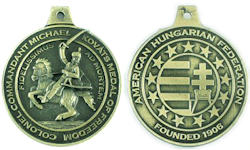 The Federation's Motto, “Faithful Unto Death,” was taken from a letter written by Col. Mihaly Kovats de Fabriczy to Benjamin Franklin. Kovats, known as the Father of US light cavalry, offered his sword in service to the United States and died in battle against the British in Charleston, South Carolina in 1779. Just as Kovats’ life and service is celebrated annually by military cadets at the Citadel, the motto reflects the values esteemed by the Federation. It also expresses the historical and inextricable ties between Hungarians and Americans, while symbolizing Hungarians’ contributions and sacrifices to America’s beginning. The Federation was established as an association of Hungarian societies, institutions and churches to “defend the interest of Americans of Hungarian origin in the United States.” The Federation's Motto, “Faithful Unto Death,” was taken from a letter written by Col. Mihaly Kovats de Fabriczy to Benjamin Franklin. Kovats, known as the Father of US light cavalry, offered his sword in service to the United States and died in battle against the British in Charleston, South Carolina in 1779. Just as Kovats’ life and service is celebrated annually by military cadets at the Citadel, the motto reflects the values esteemed by the Federation. It also expresses the historical and inextricable ties between Hungarians and Americans, while symbolizing Hungarians’ contributions and sacrifices to America’s beginning. The Federation was established as an association of Hungarian societies, institutions and churches to “defend the interest of Americans of Hungarian origin in the United States.”
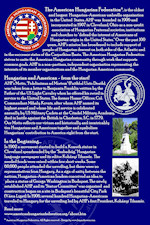 Today, the Federation strives to unite the Hungarian American community through work that supports common goals by representing the interests of a broad cross-section of that community. The Federation has been outspoken about democracy in Central and Eastern Europe and about the failure of the states neighboring Hungary to respect the rights of their Hungarian minorities or grant them their aspirations for autonomy. We are proud to be on record urging the media and policymakers to be evenhanded when it comes to Hungary. This will be especially important as the new government is sworn in." Today, the Federation strives to unite the Hungarian American community through work that supports common goals by representing the interests of a broad cross-section of that community. The Federation has been outspoken about democracy in Central and Eastern Europe and about the failure of the states neighboring Hungary to respect the rights of their Hungarian minorities or grant them their aspirations for autonomy. We are proud to be on record urging the media and policymakers to be evenhanded when it comes to Hungary. This will be especially important as the new government is sworn in."
In sum, the Federation is about service – service to our country and service to our Hungarian heritage. This service is reflected by the two recipients of our donations this year. It is an honor and privilege for us to make a contribution to the United States 1969 Claude Alexander Volunteer Program Supporting Walter Reed Medical Center and the school in Vajan, Slovakia, teaching students in their Hungarian mother tongue."
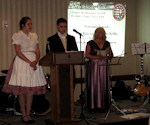 Mr. Koszorus then introduced Erika Fedor, the Ball's Chairperson and Chair of AHF's Social Committee. She also thanked all those that attended and supported the event: "We have grown in number year after year. We come together this evening not only to be in good company but also to come together to express our goals and to help a serious cause. This evenings fundraising efforts will go to support two significant causes. One recipient is a program helping wounded soldiers at the Walter Reed Army Medical Center located in Washington D.C. The second recipient is a Mr. Koszorus then introduced Erika Fedor, the Ball's Chairperson and Chair of AHF's Social Committee. She also thanked all those that attended and supported the event: "We have grown in number year after year. We come together this evening not only to be in good company but also to come together to express our goals and to help a serious cause. This evenings fundraising efforts will go to support two significant causes. One recipient is a program helping wounded soldiers at the Walter Reed Army Medical Center located in Washington D.C. The second recipient is a 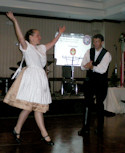 Christian Hungarian Elementary school located in a village in Vajan, Slovakia.This evening we recognize these two important groups, which are vital in their communities.
Let us all come together tonight to be guards of faith, hope and love, so that the unshakable foundation of Hungarian heritage may stand. With these thoughts I wish you all a wonderful evening with family and friends!" Scout Leaders in the
Hungarian Scouts of Washington, Sári Bárczay and Bert Kölűs, also welcomed guests. Christian Hungarian Elementary school located in a village in Vajan, Slovakia.This evening we recognize these two important groups, which are vital in their communities.
Let us all come together tonight to be guards of faith, hope and love, so that the unshakable foundation of Hungarian heritage may stand. With these thoughts I wish you all a wonderful evening with family and friends!" Scout Leaders in the
Hungarian Scouts of Washington, Sári Bárczay and Bert Kölűs, also welcomed guests.
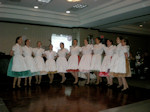 One highlight of the evening was the presentation of debutantes
from the metropolitan Washington area and dance performances. Árpád and Sylvia Fábián-Kovács performed Rábaközi Dances. Sári Bárczay, Nóra Bárczay, Sylvia Fábián-Kovács, Kata Gál,
Krisztina Kárpáthy, Andrea Kovács, Andrea Kölűs, Lydia Nyerges, Kata Seres,
Zsuzsa Seres, Emőke Tóth performed the “Sárközi Karikázó” Dance as Choreographed by Zsuzsa and Kata Seres. One highlight of the evening was the presentation of debutantes
from the metropolitan Washington area and dance performances. Árpád and Sylvia Fábián-Kovács performed Rábaközi Dances. Sári Bárczay, Nóra Bárczay, Sylvia Fábián-Kovács, Kata Gál,
Krisztina Kárpáthy, Andrea Kovács, Andrea Kölűs, Lydia Nyerges, Kata Seres,
Zsuzsa Seres, Emőke Tóth performed the “Sárközi Karikázó” Dance as Choreographed by Zsuzsa and Kata Seres.
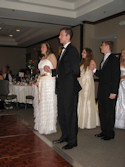 Erika Fedor presented the Debutantes Nóra Bárczay,
Viktória Lengyel, and
Lydia Nyerges. Kalman Magyar's
phenomenal Continental
Dance Orchestra (Continental Tánc Zenekar) from New York
provided music and also featured Hungarian Songs by AHF's Krisztina Wagner. The event concluded with a raffle and silent auction that included artwork by renowned Hungarian artists Mária Ábrahám, Pál Takács (sculptor of the Col. Kovats Statue at the Hungarian Embassy), and Csaba Osváth. Erika Fedor presented the Debutantes Nóra Bárczay,
Viktória Lengyel, and
Lydia Nyerges. Kalman Magyar's
phenomenal Continental
Dance Orchestra (Continental Tánc Zenekar) from New York
provided music and also featured Hungarian Songs by AHF's Krisztina Wagner. The event concluded with a raffle and silent auction that included artwork by renowned Hungarian artists Mária Ábrahám, Pál Takács (sculptor of the Col. Kovats Statue at the Hungarian Embassy), and Csaba Osváth.
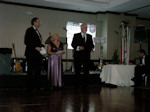 Mr. Mike Healy, President of the Claude Alexander Volunteer Program Supporting Walter Reed Hospital received the donation in support of the program he founded in 2005 to help wounded U.S. Army soldiers being treated at Walter Reed Army Medical Center in Washington, DC. Mike is a graduate of West Point and former Army Officer. Mr. Mike Healy, President of the Claude Alexander Volunteer Program Supporting Walter Reed Hospital received the donation in support of the program he founded in 2005 to help wounded U.S. Army soldiers being treated at Walter Reed Army Medical Center in Washington, DC. Mike is a graduate of West Point and former Army Officer. 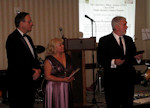 He noticed a pressing need for a program that would provide Walter Reed outpatients and their families with access to free off-post recreational events. The program is named in memory of his deceased classmate Claude Alexander, a U.S. Army officer veteran who was an inspirational mentor to many young men and women at Walter Reed, and who was very instrumental in the volunteer program's effectiveness and success. He noticed a pressing need for a program that would provide Walter Reed outpatients and their families with access to free off-post recreational events. The program is named in memory of his deceased classmate Claude Alexander, a U.S. Army officer veteran who was an inspirational mentor to many young men and women at Walter Reed, and who was very instrumental in the volunteer program's effectiveness and success.
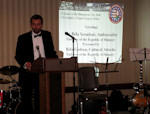 Distinguished guests included Mr. Gedeon Bela, Cultural Attache from the Embassy of Hungary; the honorable Aniko Gaal Shott; Dr. Gyorgy Kopits Gyorgy, Chairman of the Fiscal Council of the Republic of Hungary; Mr. Mike Healy, President of the Claude Alexander Volunteer Program Supporting Walter Reed Hospital; Mr. Steve Varga, President of William Penn Association, Member of the board Hungarian-American Coalition and Member of the Board of American Hungarian Federation; Mr. Maximilam Teleki, President of the Hungarian American Coalition; Mr. Imre Lendvai-Lintner, President of Hungarian Scouting Exterra; and officers and former Presidents of the American Hungarian Federation. Distinguished guests included Mr. Gedeon Bela, Cultural Attache from the Embassy of Hungary; the honorable Aniko Gaal Shott; Dr. Gyorgy Kopits Gyorgy, Chairman of the Fiscal Council of the Republic of Hungary; Mr. Mike Healy, President of the Claude Alexander Volunteer Program Supporting Walter Reed Hospital; Mr. Steve Varga, President of William Penn Association, Member of the board Hungarian-American Coalition and Member of the Board of American Hungarian Federation; Mr. Maximilam Teleki, President of the Hungarian American Coalition; Mr. Imre Lendvai-Lintner, President of Hungarian Scouting Exterra; and officers and former Presidents of the American Hungarian Federation.
Artists supporting the Ball:
Mária Ábrahám
Mária Ábrahám was born in Szeged, Hungary and today is a Hungarian-Canadian citizen residing in the city of her birth. From childhood she was inspired to perpetuate nature’s beauty by painting and drawing. Pursuing this calling, Mária captured life’s little pleasures and precious moments.
She spent a several years in the United States and Canada. This picture is Mária’s generous donation to the Hungarian May Ball to benefit its goals.
Pál Takács (1932-2000)
Paul Takacs was born in Budapest, Hungary in 1932. He attended the Academy of Applied Arts in Budapest. He was forced to flee his native country because of his active participation in the 1956 Hungarian Revolution.
His first love was painting and he began his career as an expressionist painter. His work reflected his emotional response to a world that revealed itself to him. All his works reflect a uniquely personal approach with sophisticated line drawing and sculpting techniques blend with surrealistic and folk art elements.
He designed the model of the life size bronze sculpture of Col. Michael Kovats, an American Hungarian Civil War hero, erected in front of the Hungarian Embassy in Washington, DC.
The framed study is a generous donation from Mrs. Terézia (Teca) Takács Boyne.
Csaba Osváth
Csaba Osváth is a Hungarian born artist, theologian and educator, living in Sarasota, Florida. He manages an active art studio where he teaches private classes in warm and cold glass, specializing in kiln forming techniques and contemporary mosaic work. The showcased glass bowl is a fused and slumped, functional glass piece, designed and created by the artist. The jewelry pendants are casted and cold worked wearable art pieces, containing layered dichroic glass. Osváth is the official artist for the American Association of Accountants providing hand made glass art for the annual award ceremonies.
Additional Pictures:
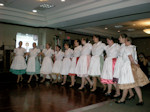 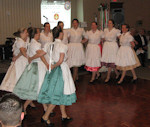 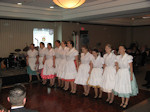
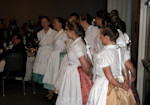  
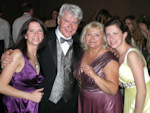 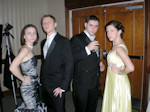 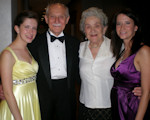
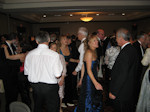 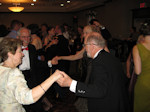 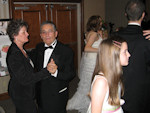
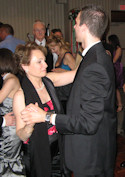 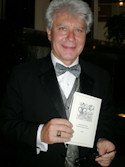 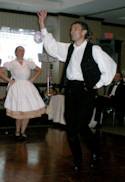
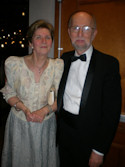 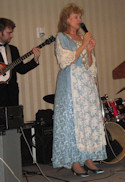 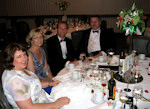
Hungarian Charity Balls
[<< Back to All AHF News]
| 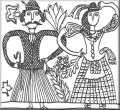
The 5th Annual
HUNGARIAN MAY BALL
and Benefit Event
The 2010 Program
Welcoming Remarks
Erika Fedor, Ball Chairperson
and
Frank Koszorus, Jr. President
American Hungarian Federation
Sári Bárczay and Bert Kölűs, Scout Leaders
Hungarian Scouts of Washington
Greetings
Mr. Béla Szombati, Ambassador
Embassy of the Republic of Hungary
Presented by
Béla Gedeon, Cultural Attache
Embassy of the Republic of Hungary
Presentation to Michael D. Healy, M.Sc.
USMA 1969 Claude Alexander Volunteer Program Supporting Walter Reed Army Medical Center
Rábaközi Dances
Árpád and Sylvia Fábián-Kovács
“Sárközi Karikázó” Dance
Coreography by: Zsuzsa Seres and Kata Seres
Performed by: Sári Bárczay , Nóra Bárczay, Sylvia Fábián-Kovács, Kata Gál,
Krisztina Kárpáthy, Andrea Kovács, Andrea Kölűs, Lydia Nyerges, Kata Seres,
Zsuzsa Seres, Emőke Tóth
Grace
Rev. László Petró
Hungarian songs by:
Christie Starley
(Wagner Krisztina)
Presentation of the Debutantes – ELSŐBÁLOZÓK
Presented by: Erika Fedor, Ball Chairperson
Nóra Bárczay
Viktória Lengyel
Lydia Nyerges
Commencement of the Ball
Raffle / Tombola
Silent Auction during the Event
“Pen and Ink Study #3” by Pál Takács
“Still Life with Flowers” by Mária Ábrahám
2010
BÁLBIZOTTSÁG / BALL COMMITTEE
- Erika Fedor (Ball Chairperson)
- Irén Högye
- Frank Koszorús Jr.
- Marianne Koszorús
- Judit Kölus
- Erszébet Tóth
- Katalin Volker
- Bryan Dawson
The American Hungarian Federation and the Hungarian Scouts of Washington deeply appreciate the generosity of the following:
PATRONS
Mr. & Mrs. István Fedor
Mr. & Mrs. László Hőgye
William Penn Association
SPONSORS
Mr. & Mrs. Theodore Boone
Mr. & Mrs. Tamás Hilberth
Mr. & Mrs. Imre Lendvay-Lintner
Mr. & Mrs. Sándor Murray
Mr. & Mrs. Ákos Nagy
The Hon. Anikó Gaál Schott
Mr. Gergely Szatmári & Ms. Jessica Jaworski
Mr. & Mrs. Maximilian Teleki
Drs. Károly & Mária Varga
Drs. Jenő & Katalin Völker
Miss Christina Maria Teresa Wagner (Wagner Krisztina)
Bethlen Communities, Ligonier, PA
DONORS
Mr. Zoltán Bagdy
Dr. & Mrs. Lajos Balla
Mrs. Csilla Bányai
Dr. & Mrs. László Csatáry
Mrs. Mária Chikes
Miss Éva Dömötörffy
Prof. August Molnár
Mr. Ernő Paróczay
Mr. & Mrs. Tibor Pflum
Mr. & Mrs. Stephen Z. Roberts
Ms. Friderika Szatmári
Mrs. Zsuzsanna Takács
Mr. & Mrs. Edward Yambrusic
About the
Hungarian Scouts [more]
 The
Magyar Cserkészszövetség, the primary national Scouting
organization of Hungary, was founded in 1912, and became a member of the
World Organization of the Scout Movement in 1990. The coeducational Magyar
Cserkészszövetség has 7,198 members as of 2004. The
Magyar Cserkészszövetség, the primary national Scouting
organization of Hungary, was founded in 1912, and became a member of the
World Organization of the Scout Movement in 1990. The coeducational Magyar
Cserkészszövetség has 7,198 members as of 2004.
Scouting
in Hungary is maintained through Magyar Cserkészet Tanácsa,
the Council of Hungarian Scouting. There are two associations in this
national federation, Magyar Cserkészszövetség, the
Hungarian Scout Association, and Magyar Cserkészcsapatok Szövetsége.
Also serving Hungarian Scouts is Magyar Cserkészlány Szövetség,
the Association of Hungarian Girl Guides.
Hungarian Scouting was founded in 1909 under Austria-Hungary, and the
first Scout group in the dual monarchy, MCA-1912 HAS, was founded in Budapest
in 1910. Scouting started in the separate nation of Hungary in 1919, at
the end of World War I, when Austria and Hungary were divided. In 1920,
the magazine Magyar Cserkész ("Hungarian Scout") was
first published.
Hungary was a founding member of the World Scout Bureau in 1922 and later
was a founding member of the World Association of Girl Guides and Girl
Scouts, WAGGGS, which was in fact established in Parád, Hungary,
in 1928.
In 1924, at the World Scout Jamboree in Copenhagen, Hungarian Scouts
attending their first jamboree came third in the competition of the nations,
behind British and American Scouts. They were especially good at water
sports.
The first Hungarian National Jamboree in 1926 had 10,000 participants.
Hungary hosted the fourth World Jamboree in 1933 at the royal forest of
Gödöllo, outside Budapest, in which 26,000 Scouts from 54 nations
camped together. The camp chief was Teleki Pál, the member of the
International Committee who later became Prime Minister of Hungary. This
was the first time there was a Jamboree subcamp for Scouts taking part
in aviation. To celebrate the 60th anniversary of the fourth World Jamboree,
the Hungarian Scout Association hosted a fourth World Jamboree Memorial
Camp at Bélapátfalva, Hungary in 1993.
After World War II, the Külföldi Magyar Cserkészszövetség
started operating in the displaced persons camps in Germany and Austria
in 1948 as the Teleki Pál Scout Association, renamed in 1948 as
the Hungarian Scout Association. Scouting was well organized and popular
in Hungary until it was officially abolished by the Communist regime in
1948, but remained nascent underground...
[read
more on Wikipedia]
Join online!

|



